Implementation of ICH Q3D Elemental Impurities Guideline: Challenges and Opportunities
Assessing risk factors is key to implementing the new ICH Q3D guidelines for elemental impurities.
Rafe Swan/Cultura/getty images

New guidelines relating to elemental impurities from the International Conference on Harmonization (ICH), Q3D Guideline for Elemental Impurities (1) have presented the pharmaceutical industry with new challenges. These challenges include the complexity of introducing new analytical technology-specifically inductively coupled plasma (ICP)-based techniques replacing the wet chemical “heavy metals” limit test-along with new and specific limits for individual elements. Perhaps the most significant challenges, however, are related to the practical implementation of the guideline.
ICH Q3D advocates the use of a risk-based approach to assessing the potential presence of elemental impurities in drug products. While such assessments are common within other aspects of pharmaceutical development, application to elemental impurity assessment presents new challenges. Specific challenges include determining how to assess or quantify the risks associated with factors such as water, container-closure systems, and excipients. Defining where in the assessment process data may be required and identifying where risks can be determined to be negligible through a thorough scientific theoretical risk assessment also present significant questions. This article seeks to review these questions by looking at the various risk factors and, where possible, weighting the risk factors based on appropriate and relevant considerations to establish an effective framework for the systematic assessment of risk and final control strategy.
Introduction of ICH Q3D
The introduction of ICH Q3D (1) is one of the most complex changes in regulations pertaining to impurities seen by the pharmaceutical industry. While the guideline is ultimately intended to focus on final drug product quality, the actual risk assessment will touch all facets of the manufacture of a drug product. The guideline introduces toxicologically relevant permitted daily exposure (PDE) limits to individual elements replacing non-specific 19th century wet chemical “heavy metal” limit tests. ICH Q3D advocates the use of a risk-based approach to assessing the potential for presence of elemental impurities in drug products. The process of executing and documenting the risk assessment is a major challenge, primarily as a result of a limited global understanding about how to assess or quantify the risk associated with factors such as water, container-closure systems, and excipients.
Defining where in the assessment process data may be required and identifying where risks can be determined to be negligible through a thorough scientific theoretical risk assessment also present a significant challenge. Where the risk assessment identifies the need for testing, the level of the PDEs for the element(s) of concern may also require the broader introduction of new, more sensitive, and specific analytical technology, adding still further to the complexity.
This article specifically seeks to examine relevant risk factors and, where possible, the weighting of these risks based on appropriate and relevant considerations. It also seeks to specifically define where in the assessment process data may be required as well as seeking to identify where risks can be determined to be negligible simply through a thorough scientific theoretical risk assessment.
The general principles outlined in this article are believed to address most scenarios or product types; however, ultimately any drug-product manufacturer needs to consider potential sources of elemental impurities appropriate for their specific product.
Risk assessment
The evaluation of the potential risk posed by elemental impurities within a formulated drug product requires a holistic approach taking into account all potential sources of elemental impurities. Figure 1 illustrates potential sources that should be considered in such an evaluation.
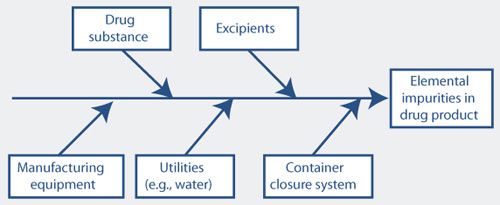
Figure 1: Sources of elemental impurities in finished drug products.
Drug substance
As presented in Figure 1, the drug substance is a key component that can contribute elemental impurities to the finished drug product. The risk of inclusion of elemental impurities from a drug substance, therefore, needs to be considered when conducting a drug product risk assessment. Control of the elemental impurity content of a drug substance can be assured through a thorough understanding of the manufacturing process including equipment selection, equipment qualification, GMP processes, packaging components, and the selection and application of appropriate control strategies.
A principal responsibility for any drug-substance manufacturer is to develop a strategy to ensure effective control of the levels of elemental impurities in the finished drug substance. An approach based on assessing and controlling potential sources of elemental impurities, coupled with focused, limited testing, is preferable to exhaustive testing on the finished drug substance. A scientific, risk-based approach combined with knowledge and control of the key sources of elemental impurities in the drug-substance manufacturing process such as catalysts, provides an efficient and comprehensive elemental impurity control strategy for finished drug substances.
Figure 2 shows potential sources of elemental impurities in the drug substance manufacturing process. Of the sources highlighted, the greatest risk comes from intentionally added metals (e.g., metal catalysts used in the process). Manufacturing equipment, processing aids, inorganic reagents, water, solvents, and other organic materials are less likely to serve as major contributors of elemental impurities in the finished drug substance, but do require consideration.
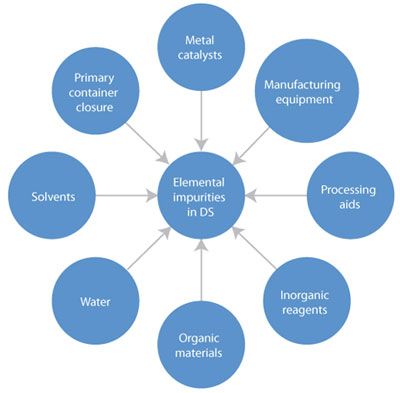
Figure 2: Primary sources of elemental impurities in drug substances (DS).
Metal catalysts. Metal catalysts such as palladium and platinum are often used in the drug-substance manufacturing process and can therefore be present at low levels in the finished drug substance. The synthetic route should be reviewed for intentionally added metals, and data from purging studies, including any supportive testing of appropriate isolated intermediates, should be used in the design of an appropriate control strategy.
The ability to remove the catalyst (purge capacity) will be influenced by catalyst loading and the nature of the catalyst used in the process (i.e., homogeneous vs. heterogeneous catalysts). Heterogeneous catalysts, such as palladium on carbon, are often easily removed from reaction mixtures by filtration, and therefore, the risk of carryover of elemental impurities into the drug substance is typically low. Even in cases where metal catalysts are used in the final stages of the process, good historical data and/or understanding of carry-over may permit reduced testing schemes.
Biotech products do not normally rely on the use of catalysts. As ICH Q3D points out, typical purification schemes in biotech drug substance manufacturing are well capable of clearing any elements introduced either intentionally or inadvertently “to negligible levels.” The principles outlined previously may nonetheless be relevant in some specific cases (e.g., chemically modified biotech drug substances).
When considering the other potential sources highlighted in Figure 2, it is recommended to focus primarily on the manufacturing steps that occur after the formation of the final intermediate. Washes, crystallizations, phase separations, chromatography, distillations, and processing aids/scavengers aid in purging of elemental impurities and, therefore, reduce the risk of carryover into the finished drug substance from stages earlier in the upstream process. Areas for further consideration include manufacturing equipment, processing aids/inorganic reagents, solvents, water, and packaging.
Manufacturing equipment. In general, GMPs, including equipment compatibility assessment and qualification, are sufficient to ensure that significant levels of elemental impurities are not leached from manufacturing equipment into the drug substance. Hastelloy, stainless steel, and glass are the most commonly used materials of construction for drug substance manufacturing equipment, due to their superior chemical resistance. Nickel, cobalt, vanadium, molybdenum, chromium, and copper are key elements in some Hastelloy and stainless-steel alloys. Under extreme/corrosive reaction conditions, such as high temperature and low/high pH, these elements could have the potential to leach from manufacturing equipment. In such cases, it may be necessary to supplement standard GMP equipment compatibility assessments with specific studies to assess the elemental impurity-leaching propensity from manufacturing equipment due to corrosive reaction conditions.
Other potential sources include high-energy processes such as milling/micronization equipment. These are also generally considered to be low risk, but should be addressed via appropriate GMP including cleaning records and visual inspection. Particle size reduction is discussed in the Drug Product Manufacture section.
Processing aids/inorganic reagents. Processing aids such as charcoal, silica, celite, and darco, and inorganic reagents such as sodium chloride, magnesium sulfate, and sodium sulfate, are often used in drug-substance manufacturing processes and may be used in significant quantities. Depending on their specific composition, inorganic reagents should be considered within the risk assessment, especially when ICH Q3D elements are integral to the formula. The levels used should also be considered as some reagents may be employed in higher relative amounts (i.e., in stoichometric amounts). In such instances not only the elements (intentionally) present in the reagents, but also reagent purity (or lack thereof) need to be taken into account.
In general, the use of such reagents presents a low risk. In studies conducted within the organizations associated with this article, there is little evidence to support such materials being a significant risk. Therefore, the risk assessment should primarily focus on processing aids and inorganic reagents used late in the drug substance manufacturing process, and/or where aggressive reaction conditions exist (e.g., extreme pH/high temperatures for prolonged times).
Solvents. Most solvents used in the manufacture of drug substances, particularly those listed in ICH Q3C, Impurities: Guideline for Residual Solvents (2) Class 3, are unlikely to contribute elemental impurities to the finished drug substance. The majority of solvents are purified by distillation and few involve the direct use of metal catalysts in their manufacture; hence they are considered a low risk source of elemental impurities. In the event that solvents have not been purified by distillation, especially if a catalyst in used in their manufacture, further evaluation in the risk assessment should be considered.
Water. Refer to the environmental factors discussion is the Drug Product Manufacture section.
Packaging. Packaging is discussed in the section Container-closure Systems (CSS) as a Potential Source of Elemental Impurities in Finished Drug Product.
Evaluation option limits. It must be recognized that, from a compliance perspective, the limits for elemental impurities in ICH Q3D apply only to the drug product. To ensure effective control of the level of elemental impurities in the drug substance a number of options are available:
- The ICH Q3D option 1 concentration limits assume a maximum daily drug product intake of 10 g/day. Drug substances that meet option 1 concentration limits can be used at any dose in the drug product.
- ICH Q3D option 2 concentration limits are calculated specifically based on the actual daily drug product intake (and composition) and may provide higher concentration limits than option 1 (if the maximum daily intake of drug product is <10g).
The acceptable level of elemental impurities in a drug substance may be defined and agreed upon in a suitable quality agreement between the drug substance manufacturer and the drug product manufacturer.
Conclusion for drug substances
While drug substance manufacturing often involves a complex series of processes, some simple scientific principles can be applied to ensure that elemental impurity levels in the final drug substance are controlled to appropriate levels. The application of a risk-based control strategy, involving an understanding of the manufacturing process and key sources of elemental impurities, appropriate equipment selection/qualification, adoption of suitable GMP processes/procedures, and the selection and application of appropriate control options will typically result in the manufacture of drug substances with elemental impurity levels well below ICH Q3D option 1/option 2 concentration limits. This overall low risk status is supported by the emerging dataset from ICP-optical emission spectrometry (OES) and ICP-mass spectrometry (MS) screening of a wide range of drug substances plus the significant body of historical heavy-metals test data.
Excipients
One of the greatest challenges to performing an elemental impurity risk assessment for a drug product is to understand the potential contribution of elemental impurities from excipients.
Elemental impurities of concern for excipients would typically be:
- Class 1 and Class 2a elements potentially present at trace levels in the excipient based on environmental factors
- Intentionally added catalysts or reagents for synthetic excipients
- Class 3 elements from excipients that are targeted for a specific route of administration (e.g., inhaled).
Unlike drug substances, there may be less information available from excipient vendors with respect to the manufacturing equipment and processes used (e.g., any high energy steps, corrosive reagents, or added catalysts), which may potentially introduce elemental impurities. While many vendors will supply, on request, a compliance statement with the European Medicines Agency (EMA) metal catalyst guideline (3), the elemental impurity testing reported on the certificate of analysis is typically based on a non-specific, wet chemistry heavy-metals limit test with the result reported as less than the specification value in parts per million. When considering the risk of elemental impurities potentially being introduced into the drug product via excipients at levels greater than the PDE, the following points should be considered:
- Source of the excipient (mined, plant, animal, synthetic, etc.)
- Excipient level in the formulation (wt. %) (4)
- Drug-product daily dose.
Source of the excipient. The origin of an excipient can have a significant impact on the degree of risk associated with elemental impurities. Figure 3 provides a useful guide.
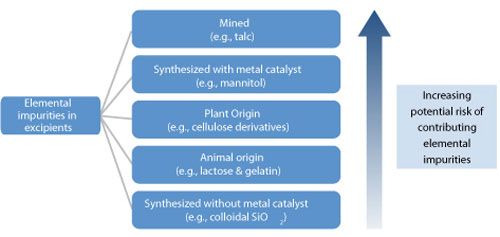
Figure 3: Potential sources of elemental impurities in excipients.
Mined excipients may exhibit a natural variation depending on the location of the mine and the natural geology. The potential levels of elemental impurities from mined excipients may be more variable and therefore pose a higher risk than synthetic excipients manufactured using metal reagents and/or catalyst where the levels are less variable as a result of well-defined manufacturing processes and controls.
Excipients harvested from plants also pose a potential risk as a result of their uptake of metals from their environment. Synthetic excipients that are manufactured without the use of metal catalysts and/or reagents present the lowest risk of introducing elemental impurities to the drug product.
Proportion of formulation. An essential consideration in determining the risk contribution for elemental impurities from an excipient is the proportion of the excipient used in the formulation. The risk contribution from a mined excipient used as a filler or diluent (typically >20 wt% of the blend), for example, will be greater than the risk contribution of a mined excipient used in a tablet film coat (typically <5 wt%).
Generally, low-weight percentage components that are not mined are regarded as low risk; however, the daily product dosing and route of administration also need to be considered.
Dose/route of administration. Dose and dosing regimens should also be considered. A low, orally administered, daily dose clearly presents a lower risk than an inhaled product as shown by the lower PDE limits for inhalation vs. oral found in Table A.2.1 of the ICH Q3D guideline (1).
Conclusion for excipients
The above principles can be used as part of an excipient risk assessment and are a useful guide in the absence of data. In addition, manufacturers should consider the principles for controlling elemental impurity generation from manufacturing equipment, as described in the Manufacturing equipment section for Drug substances.
With the pending removal of United States Pharmacopeia (USP) <231> from the United States Pharmacopeial Convention, however, uncertainty exists as to whether excipient manufacturers and vendors will test for elemental impurity concentrations and, if so, for what elements, to what levels, and using what procedures/equipment.
It must be recognized that, from a compliance perspective, the limits for elemental impurities in ICH Q3D only apply to the drug product. Excipient manufacturers may, however, be requested to assist in assuring compliance through awareness of the level of elemental impurities within the excipient itself. In addition, the same general principles of evaluation options for drug substances described previously apply to excipients.
In some instances, it may be appropriate to define and agree on the acceptable level of elemental impurities in an excipient through a suitable quality agreement between the excipient manufacturer and the drug product manufacturer.
Ultimately, it is the responsibility of pharmaceutical manufacturers to demonstrate, via risk assessment and/or data, that the drug product is compliant with ICH Q3D. To this end, the development of a common database for excipient elemental impurity profiles will be a useful activity to support risk assessments. The International Pharmaceutical Excipients Council of the Americas (IPEC-Americas) and FDA have performed an exercise examining elemental impurity levels from multiple excipients, which is planned for publication. This information indicates that the vast majority of excipients (analyzed by ICP-MS) contain elemental impurities at levels unlikely to cause concerns at typical usage levels in oral solid dosage forms.
Table I: cGMP controls for selected operating conditions in drug product manufacture.
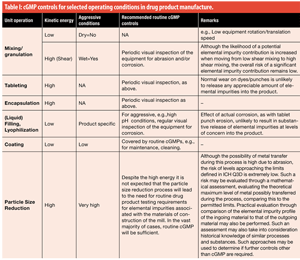
Drug product manufacture
The drug-product risk assessment needs to consider the potential elemental impurity contribution from the drug product manufacturing equipment/process. Manufacturing for solid products encompasses a large variety of processes, such as solid mixing (blending), granulation, tableting (compression), coating, and particle size reduction. For liquid product manufacture, dissolution or suspension of solid excipients and drug substance is often carried out in metallic equipment. In contemporary cGMP facilities, the likelihood of additional contribution of elemental impurities is negligible. However, there is a theoretical risk associated with Class 2A metals such as vanadium, nickel, etc., because these elements are commonly found in manufacturing equipment; for example, 316L stainless steel contains approximately 10% w/w nickel. Therefore, understanding the drug product equipment in terms of materials of construction will be a key factor in completing the risk assessment. The risk assessment should focus on any steps involving high kinetic energy (solids) or corrosive liquids that may facilitate the transfer of elements from the equipment into the product.
A consideration of typical drug product manufacturing steps and conditions is provided in Table I.
Manufacture of liquid dosage forms. Processing a liquid product containing a drug substance, excipients, and solvent (typically water-based buffer) in metallic vessels can potentially facilitate the transfer of elements into the liquid drug product, particularly at high/low pH. An assessment of material compatibility should be completed, taking into account factors such as ionic content, pH, temperature, hyrdophilicity/hydrophobicity, terminal sterilization conditions, and contact time. Testing should only be required if this assessment identifies a substantive risk.
Conclusion for drug product manufacture
In general, the risk for elemental impurity contribution due to processing of solid drug product components in cGMP facilities is low, as stated explicitly in ICH Q3D. Although much equipment used to process drug product is metallic (e.g., stainless steel vessel), the majority of the processes used in drug product manufacture can be discounted as a source of risk. Even areas highlighted as needing consideration (Table I) are expected to only result in controls outside routine cGMP in extreme cases.
Environmental factors. As part of the holistic risk assessment of elemental impurities described in ICH Q3D, there is a need to consider the potential contribution resulting from environmental factors such as water and air.
Water. Water used in the manufacture of both drug substances and formulated drug products is a potential source of elemental impurities. The level of risk, however, may be strongly related to the quality of water. This risk was examined in detail in a USP stimuli article on water for pharmaceutical use (5). The following position was articulated:
- The source water used in drug product manufacturing must meet the World Health Organization (WHO) standard for drinking water. When this source water is further purified in a contemporary plant to generate purified water (PW) and/or water-for-injection (WFI), the elemental impurity levels should be below acceptable concentrations allowed for drug roducts using option 1 control strategy defined in ICH Q3D.
- As part of standard GMP, water quality should be routinely monitored and the purification system and storage of the water should not re-introduce elemental impurities.
Based on this position, the risk of elevated elemental impurity levels within aqueous-based formulations-even large-volume parenterals-is considered negligible. The risk associated with the use of water in the manufacture of the drug substance can also be effectively eliminated through the appropriate use of WHO-standard potable water combined with the use of USP purified water for the final stage in the manufacture of the drug substance, including its isolation.
Air. Air is not likely to present a substantive risk; furthermore, air quality can also be managed through proper GMPs via use of HEPA filtered air, etc. No specific assessment is therefore generally required.
Container-closure systems as a potential source of elemental impurities in finished drug product
One of the potential sources of elemental impurities is product packaging, often referred to as container-closure system (CCS). In determining the risk posed by the CCS, there are a number of factors that need to be taken into consideration including:
- Nature of formulation--mechanism for contamination
- Level of metals present in the CCS
- Nature of risk: safety vs. quality risk
- Duration of storage (liquids).
In terms of the type of formulation, it is inconceivable that substantive or even trace-level contamination would occur where physical contact is limited to solid-to-solid contact. This is entirely consistent with the FDA Guidance for Industry, Container Closure Systems for Packaging Human Drugs & Biologics (6), which in relation to extractables and leachables considers solid-to-solid contact of low risk. It is therefore reasonable to conclude that any assessment of risk associated with CCSs should be limited to those associated with either liquid or semi-solid formulations.
The second aspect of any risk assessment of the CCS involves an understanding of the potential levels of metals present within the material concerned. A major review of materials in manufacturing and packaging systems as sources of elemental impurities in packaged drug products was published in 2013 (7). The publication summarized literature data for a number of common packaging materials, including levels of elemental impurities within the component material (determined by digestion), as well as elemental impurities extracted from the component materials. The data, while fragmentary, are nevertheless comprehensive, and several key conclusions were drawn. While certain materials were found to contain elemental impurities, the presence of the elemental impurity was predominantly associated with deliberate use of metal catalysts, for example the use of antimony in the manufacture of polyethylene terephthalate (PET). In the case of PET, levels of antimony of approximately 50 ppm are typical (full digestion). Focusing particularly on those elements of high concern (Class 1 and Class 2), only fragmentary data exist to suggest even trace levels present within the component material, for example cadmium and lead levels up to 100 ppm were reported in polyvinyl chloride. Even when low levels of elemental impurities are present in the material itself, the effective “availability” of the elemental impurity needs to be considered. What is consistently clear from the extraction data presented is that extracted elemental impurity levels (under relevant conditions) are a minute fraction of the total elemental impurity levels present in the component materials, typically <0.1% of that observed following digestion. Therefore, even when trace levels of certain elements are found in the component material, the available elemental impurity concentration may represent an extremely low safety risk (Figure 4).
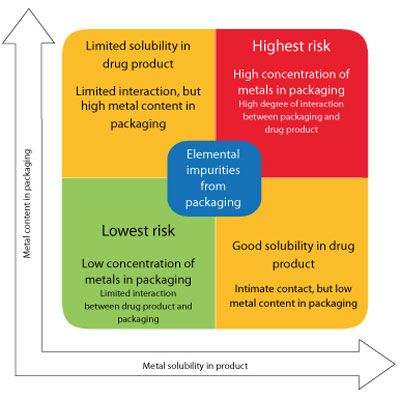
Figure 4: Illustration of risk factors associated with packaging.
There may, however, be potential quality-related risks. Such risk may result from potential metal-catalyzed degradation of the product in question. While the interaction between packaging material and solid dosage forms is negligible (ICH Q3D), this may not always be the case for non-solid drug products. Reported examples include iron (8), nickel (9), and tungsten oxide. In the case of tungsten, this related to leaching from the syringe barrel, causing protein aggregation (10). As a consequence, many biopharmaceuticals include ethylenediaminetetraacetic acid to “mop up” metals. Assessments of such risks should be addressed on a case-by-case basis.
Evaluations should thus focus on liquid and semi-solid formulations. Detailed leachable studies should only be required where there is a lack of elemental impurity extractives data for the packaging components in question.
Analytical testing
Analytical testing for elemental impurities is clearly an important aspect of the assessment of elemental impurities. It is not, however, within the scope of ICH Q3D. The guideline states that “Pharmacopoeial procedures or suitable validated alternative procedures for determining levels of elemental impurities should be used, where feasible.”
USP has developed General Chapter <233> “Elemental Impurities-Procedures” (11), and the European Pharmacopoeia (Ph.Eur.) has recently published general chapter 2.4.20 “Determination of Metal Catalyst or Metal Reagent Residues” covering analytical testing (12). USP <233> describes two specific procedures for the evaluation of the levels of metal impurities. Importantly, it also describes criteria for the use of alternative procedures. Thus, a flexible approach may be adopted in terms of the analytical procedure, provided the method concerned meets the required acceptance criteria.
Control strategy
A drug-product risk assessment can use prior knowledge of the input materials to demonstrate that the risk of significant elemental impurity levels is low across multiple batches. When the risk assessment concludes that elemental impurities are below 30% PDE, it should be acceptable to rely on the quality system to maintain the control of the process and the existing use of standard cGMPs as a control strategy of the drug product, without requiring any additional element-specific testing on each batch of product.
Other factors to consider could include:
- Security of external supply chain along with a quality history (e.g., audit history, levels of complaints, recalls, etc.) for each vendor
- Control of vendor elemental impurity specifications and elemental impurity reporting on ingredient certificates of analysis
- Security of internal supply chain.
It is anticipated that a properly executed and documented elemental impurity risk assessment for the majority of drug products may justify the use of standard cGMP as being a sufficient control strategy to ensure levels of elemental impurities meet the levels defined in ICH Q3D, without the need for additional testing.
Where the drug product elemental impurity risk assessment identifies the need for additional elemental impurity control, it is crucial to first understand the potential source of the elemental impurity(s). Once the source is known, appropriate controls, in addition to cGMP, can be applied. The flow chart in Figure 5 can be followed to help determine when additional controls are required and what those controls may look like.
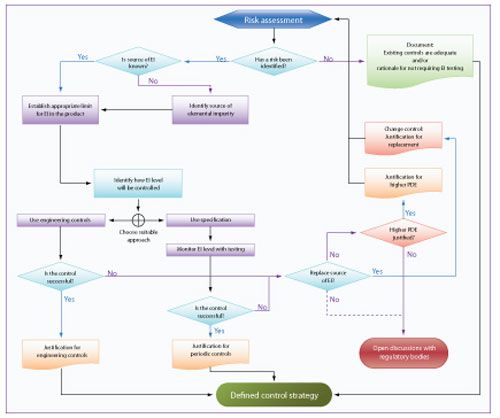
Figure 5: Elemental impurity control strategy. (Click image to enlarge.)
Lifecycle management
Product and/or process changes have the potential to change the elemental impurity content of the final drug product. Therefore, their impact on the overall risk assessment, including established controls should be evaluated. Such changes could include, but are not limited to, changes in synthetic routes, excipient suppliers, raw materials, processes, equipment, container closure systems, or facilities. All changes are subject to internal change management process ICH Q10 Pharmaceutical Quality System (13) and, if needed, appropriate regional regulatory requirements.
Conclusion
The implementation of the ICH Q3D guideline can be adequately achieved through using an appropriate risk-based process combined with existing GMP standards. A risk assessment should be performed to identify any elemental impurities that may potentially be present at significant levels in the drug product. Such an assessment is then used to define an appropriate control strategy. ICH Q3D allows the option that the scope and extent of quality control testing may be reduced, or even eliminated provided there is adequate control. In many cases, this can be successfully achieved through the use of appropriate GMP controls both in terms of input materials and manufacturing processes, limiting testing to those areas clearly identified as a substantive risk.
Acknowledgements
The authors would like to thank Patrick Drumm, Mark Schweitzer, and Darragh Norton of Novartis, who also contributed to the article.
References
1. ICH, Q3D Guideline for Elemental Impurities (2014).
2. ICH, Q3C Impurities: Guideline for Residual Solvents (2011).
3. EMEA, Guideline on the Specification Limits for Residues of Metal Catalysts or Metal Reagents, EMEA/CHMP/SWP/4446/2000 (2008).
4. IPEC Americas, PDE Calculator, http://ipecamericas.org/content/pde-calculator, accessed Feb. 17, 2015.
5. T. S. A. Bevilacqua, “Stimuli to the Revision Process: Elemental Impurities in Pharmaceutical Waters,” Pharmacopoeial Forum 39(1) (2013).
6. FDA, Guidance for Industry: Container Closure Systems for Packaging Human Drugs and Biologics (Rockville, MD, May 1999).
7. D. Jenke et al, PDA J Pharm Sci and Tech, 67, 354-375 (2013).
8. I. Beck-Speier et al., Particle and Fibre Toxicology, 6, 34-36 (2009).
9. M. Schmidt et al., Nature Immunology, 11, 814-820 (2010).
10. J. Bee et al., J Pharm Sci, 98, 3290-3301, (2009).
11. USP General Chapter <233> “
”.
12. Ph.Eur. General Chapter 2.4.20, EDQM, Strasbourg, France).
13. ICH, Q10 Pharmaceutical Quality System (2008).
All figures are courtesy of the authors.
About the Authors
*Andrew Teasdale is a principal scientist at AstraZeneca, andrew.teasdale@astrazeneca.com.
Cyrille C. Chéry is a senior scientist, analytical sciences for biologicals, UCB Pharma SA.
Graham Cook, PhD, is a senior director, Pfizer Global Quality Intelligence and Compendial Affairs.
John Glennon is a stability laboratory team leader, GlaxoSmithKline.
Carlos W. Lee is a Associate Research Fellow, analytical research and development, pharmatherapeutics pharmaceutical sciences, Pfizer, Inc.
Laurence Harris is an associate research fellow, analytical research and development, pharmatherapeutics pharmaceutical sciences, Pfizer, Inc.
Nancy Lewen is a senior principal scientist, Bristol-Myers Squibb.
Phil Nethercote is analytical director, product quality, global functions at GlaxoSmithKline.
Samuel Powell is a scientist, analytical research and development, pharmatherapeutics pharmaceutical sciences, Pfizer, Inc.
Helmut Rockstroh is head, pharmacopoeial affairs office, F. Hoffmann-La Roche Ltd.
Laura Rutter is a SM manager, analytical services at GlaxoSmithKline.
Lance Smallshaw is worldwide analytical expert for biologics and strategies, corporate analytical sciences, UCB.
Sarah Thompson is an associate principal scientist at AstraZeneca.
Vicki Woodward is a technical services manager at AstraZeneca.
Katherine Ulman is vice chair of science and regulatory policy for IPEC-Americas and a global regulatory compliance manager at Dow Corning.
*To whom all correspondence should be addressed.
Article DetailsPharmaceutical Technology
Vol. 39, Issue 3
Pages: 36–49, 89
Citation: When referring to this article, please cite as A. Teasdale, et al., “Implementation of ICH Q3D Elemental Impurities Guideline: Challenges and Opportunities,” Pharmaceutical Technology 39 (3) 2015.

INTERPHEX 2025: Use of Walk-In Chambers for Bio/Pharma Development and Manufacturing
April 2nd 2025Sitting down with the PharmTech Group at INTERPHEX 2025, Christopher Murphy, director of Global Business Development and Service Customer Support at Environmental Specialties, discusses the design and critical role of walk-in chambers in the bio/pharmaceutical industry.
WMFTS’ BioPure to Showcase Single-Use Bioclamp with Refined Manufacturing at INTERPHEX 2025
April 1st 2025With advanced manufacturing, BioPure’s BioClamp connector is manufactured to be 13% lighter than the previous model, resulting in a 26% reduction in carbon dioxide emissions across the full lifecycle of the product.